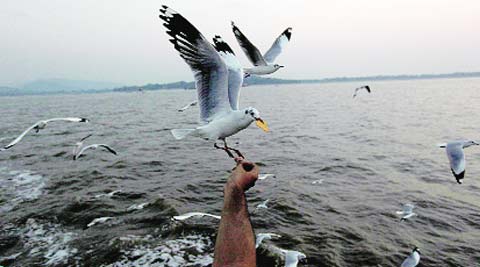The prediction for sea level rise in Mumbai is oddly less than half the average rate of rise over the past 203 years of only ~4 inches per century.
Meanwhile, Pachauri's other organization the IPCC predicts, on the basis of highly-flawed and overheated climate models, that global sea level rise will be 52-98 cm by 2100, a rate of 23.8 - 38.6 inches per century, more than 24 times faster than for Mumbai. How is that possible?
Mean sea level along Mumbai to rise by 4 cm in 100 yrs: Study
Written by Anjali Lukose | Mumbai | April 17, 2014 3:43 am

In the 2050s, the increase in the mean sea level along the Mumbai coast may be around 2 cm and it would increase to around 4 cm by 2100.
SUMMARY
The study was conducted by The Energy and Resources Institute (TERI), an environmental research institute.
The mean sea level along Mumbai’s coast is likely to rise by around 4 cm while warmer nights, increased rainfall, decline in crop productivity and health issues stare Maharashtra in the next 100 years, finds a study on “Assessing climate change vulnerabilities and adaptation strategies for Maharashtra”.
The study was conducted by The Energy and Resources Institute (TERI), an environmental research institute, in partnership with Met Office Hadley Centre, United Kingdom’s climate change research centre for the state environment department.
Coastal flooding, the report warned, could lead to reduction in availability of fresh water due to saltwater intrusion as well as contamination of water supply through pollutants from submerged waste dumps. The temperature in Mumbai and the rest of Maharashtra is likely to increase by 1 to 3 degrees in the next 50 years, and evening or nights would be warmer by 1.5 to 2 degrees.
The study is part of the state environment department’s project to study impact of climate change in Maharashtra and devise district-wise plans. “It is important for the state to develop its own strategy and be prepared to meet challenges posed by climate change,” said R A Rajeev, principal secretary, environment department. “TERI has submitted a draft report and we had some queries so they are finalizing the report.”
In the 2030s , TERI has predicted that the state’s coastal regions, which include Mumbai, Navi Mumbai and Thane and eastern Maharashtra, will have higher ambient temperature compared to central Maharashtra.
“If the rainfall increases as predicted, combined with an increase in sea levels, construction close to the sea could be affected because of heavy flooding, which is a grave situation for a coastal city like Mumbai,” said Subimal Ghosh, an associate professor in IIT-B’s civil engineering department and researcher on climate change. “We need to conserve our water resources and come up with better alerting systems during extreme climate events in Mumbai.”
In the 2050s, the increase in the mean sea level along the Mumbai coast may be around 2 cm and it would increase to around 4 cm by 2100, according to the executive summary report of the study. Due to increasing temperature and rainfall, coastal and eastern Maharashtra are vulnerable to malaria outbreaks in the future, predicts the study. Even rainfall shows an increasing trend with TERI’s prediction of a 20-40 per cent increase in rainfall through the state.
However, the mean temperature in the state has risen only between 0.5 to 2 degrees and rainfall showed a significant increase only in the Konkan region in the past 100 years, according to A K Srivastava, director of National Climate Centre, Indian Meteorological Department (IMD) Pune.
Across Maharashtra, Nandurbar was found to be the district that would be the most vulnerable to climate change, followed by Dhule and Buldhana, while Satara followed by Ratnagiri and Sindhudurg would be the least vulnerable districts.
No comments:
Post a Comment